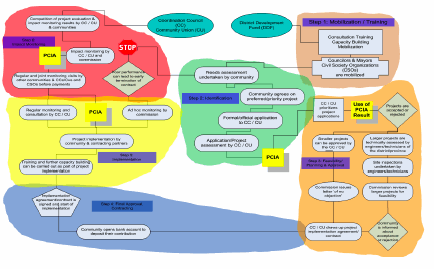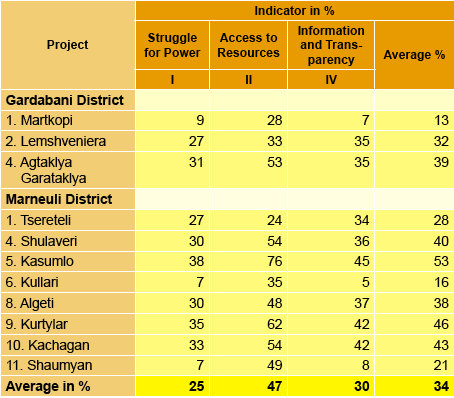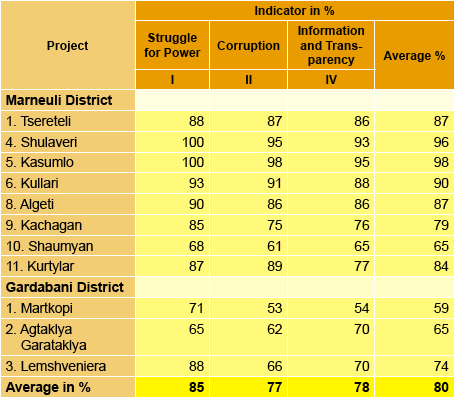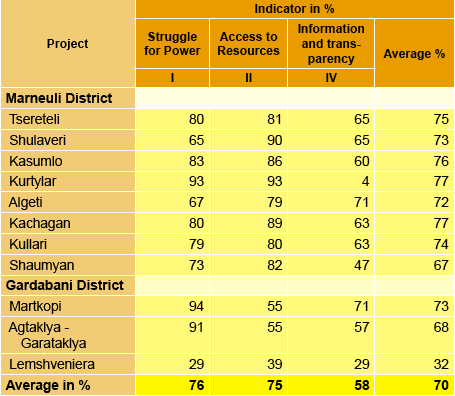 |
I. Introduction
From 2002 to 2006, German Technical Cooperation (GTZ) operated the Food Security, Regional Cooperation and Stability in the South Caucasus (FRCS) programme. The programme aimed to improve the living conditions of people inhabiting the border regions of Armenia, Azerbaijan and Georgia, and to foster the conditions necessary for sustainable economic and social development. This Application Example describes the application and integration of a Peace and Conflict Impact Assessment method into FRCS’s community development activities in its Georgia project area.
In Georgia, the FRCS programme operates in the Kvemo Kartli region, specifically the districts of Gardabani and Marneuli. The districts share borders with Azerbaijan to the east and Armenia to the south. The Marneuli district consists of approximately 83 percent ethnic Azerbaijanis. Ethnic Georgians, who make up only 6.4 percent of the population, hold the highest regional government posts in Marneuli, having often been appointed to these positions by the central government in Tbilisi. In the Gardabani district, the ethnic composition is 45 percent Georgian and approximately the same percentage Azerbaijani. The lack of cultural and political integration among ethnic groups, along with the disproportionate distribution of power, is a constant source of low-level conflict in south-eastern Georgia. The area also struggles with significant socio-economic problems, including high unemployment, severely degraded infrastructure, collapsed economic and social networks, and increasing social stratification. Unless constructive means of dealing with the tensions and conflicts are developed, the region will remain unable to reduce poverty, become food secure, and meet its development potential.
One component of the FRCS programme is community development, including local self-governance and civil society development. Coordination Councils (CCs) were established in each district to improve general performance of local self-governance, build institutional capacities, and empower local self-governance bodies to be more responsive to local needs. All local self government (LSG) units in the district are the members of a CC. Each CC administers a District Development Foundation (DDF), which accepts project proposals from the communities and finances them to a significant extent. Financial support for the activities of the CCs and the DDFs was initially provided by FRCS for small scale projects. By offering a limited amount of money (compared to the overall need in each district) LSG representatives in the board of the CC needed to find a way to take decisions based on mutually accepted objective criteria. In other words , a conflict around limited resources was created with the goal of ‘solving’ this resource conflict in a transparent and peaceful manner. To select which projects to fund, the CCs established selection criteria, such as the sector’s significance (i.e. infrastructure, agriculture, small and medium enterprises), technical and financial feasibility, community contribution, number of beneficiaries, poverty levels, and potential.
|
|

|
To monitor the impact of its interventions in the highly sensitive setting of the South Caucasus, FRCS used tools such as local conflict analysis, round table discussions, and Peace and Conflict Impact Assessment (PCIA). A team from the Centre of Advanced Training in Agricultural and Rural Development of Humboldt University in Berlin, together with the FRCS team, developed the PCIA tool and expanded it into a very useful and important assessment tool. The PCIA tool was integrated into the work of the CCs and the DDFs with the support of civil society representatives who were not part of the CCs. Civil society representative were trained and equipped with skills and knowledge in community development, political involvement, and representation as part of an overall civil society capacity building program. A pool of local trainers was selected to provide further training to local self-governance and civil society representatives.
The following section provides a short description of PCIA and how it was used in the South Caucasus.
II. What is PCIA?
Development interventions inevitably affect existing conflicts and tensions and may create new ones. PCIA consists of continuous observation and analysis of the relation between the development interventions of organizations like CCs and the peace and conflict environment. Utilizing PCIA provides feedback on whether these effects are positive or negative. It helps measure the risk of programs and assures the conflict sensitivity of projects. Additionally, it creates a learning process that sensitizes local stakeholders to peace and conflict related impacts.
In the South Caucasus, PCIA was developed for use by the Coordination Councils to assess the impacts of development activities on identified peace and conflict fields. The results provides grounded ideas and feedback on how civil society could support the work of the CCs as well as other interested stakeholders involved in development work in the South Caucasus.
|
 |
III. Development of the PCIA Tool
A team of post-graduate students from the Centre of Advanced Training in Agricultural and Rural Development of Humboldt University (CATAD), together with the FRCS project team, designed and developed the tool. The work was separated into two phases: the preparatory phase and the field phase. In the preparatory phase, the group engaged in analysis of the project region and discussions with experts in order to gain a deeper understanding of the overall political, economic and cultural settings. Based on the work in this initial phase, the group developed a concept for field research. In the field phase, the group applied the concept to the local context, finalized it, created awareness and sensitized stakeholders, and drafted an application manual with interview guides and checklists.
It is important to note that the baseline surveys carried out by FRCS in the project regions in each country and the findings of the local conflict analysis provided important background information during the development of the tool.
Before developing a Peace and Conflict Impact Assessment, the fields of observation, the so-called ‘peace and conflict fields’ must be defined. In the case of the South Caucasus, particularly the project area in Georgia, the following peace and conflict fields were identified as most relevant for the community development component of FRCS:
- struggle for power,
- access to resources,
- corruption,
- information and transparency,
- regional cooperation, and
- cultural diversity.
For each of the above fields, ‘impact hypotheses’ were developed that
anticipated both intended and unintended impacts. For example, one of the impact hypotheses for the field of “struggle for power” was:
Participatory decision making processes and transparency lead to mutual understanding and a more equal distribution of power.
The next task was to find suitable indicators by which the impacts could be measured. Indicators describe a situation that can be observed and that verifies that the impacts are occurring. An indicator for “struggle for power” is:
Representatives of various community groups are involved in decision-making and their interests are being taken into account.
For each indicator, a questionnaire with 10 to15 questions was drafted for use with the community members and administrators. Additionally, data collection checklists for projects were developed on the basis of the indicators with possible answers and scorings for each conflict field. The points were added up and an average percentage of each indicator/conflict field calculated. Any score under 50 percent signifies a high risk of negative effects of the specific community development intervention on the conflict field.
After several field trials, the final PCIA manual was refined to include a list of indicators, including monitoring results for peace and conflict impacts; check lists of questions and the scoring table for monitoring infrastructure, agriculture, capacity building projects; instructions on how to use the checklists and how to connect them with the indicators; suggestions for how to monitor the risks that the conflict environment holds for the work of the CCs; a training manual with the steps of how to apply a PCIA; and methodological advice on how to expand or further develop the tool.
|
|

|
IV. PCIA Application
The application of the final tool was carried out in two phases: (A) the design, testing, and capacity building phase, and (B) the implementation phase.
A. Design, testing, and capacity building
Before the PCIA tool could be implemented, the following steps were taken to ensure its validity and efficacy:
- Testing, presentation and adjustment. The first test of the PCIA tool was made by FRCS employees. Further testing was conducted by local trainers and civil society representatives who were instructed by FRCS employees. The questionnaires were adjusted and simplified.
- Regional Training of Trainers on PCIA. The training of trainers was conducted for local trainers from FRCS’s project areas in Armenia, Azerbaijan and Georgia, reflecting the need for a capable pool of trainers who are able to introduce the PCIA tool to interested stakeholders throughout the region. The participants were equipped with the requisite theoretical knowledge, skills, and instruments to provide further trainings on PCIA. After the ToT, the local trainers were expected to introduce PCIA to civil society and other interested stakeholders, to carry out trainings on PCIA for civil society representatives, and to coordinate, consult and advise civil society groups during the integration and application of PCIA on community projects.
- Presentations to civil society representatives and Coordination Councils.
- Training on PCIA tool to civil society. The training aimed to develop local human resources capable of conducting a Peace and Conflict Impact Assessment in their communities. Participants were mainly young people. The tool was introduced in detail to participants. Aims, value and conflict fields were presented and discussed. Case studies were used to practice the checklists and process the data.
- Selection of interviewers. Interviewers were selected based on agreed criteria, including objectivity, commitment, connection (the person could not be a complete outsider), and language abilities.
- Workshops with LSG representatives. Depending upon need and requests from community mayors, workshops were conducted in each community explaining what PCIA is and what it seeks to accomplish. At the same time, participatory methods of working in communities were discussed.
The concept of PCIA was presented to civil society organizations to interest them in PCIA-related activities and ensure a capable human resource pool in the communities to conduct the PCIA. Presentations were made to the CCs to introduce the PCIA tool, obtain feedback, and initiate the process of gradual introduction and integration of the tool to the activities of CCs.
This phase of the process was especially important since the application of the PCIA tools is an intervention itself that can have positive and negative effects on conflict dynamics. E.g. a massive questioning of people in a village where not everybody is well informed about the purpose and the further use of the data allows for a great deal of speculations and manipulations. An intense preparatory phase was important to be conflict sensitive in the application of the PCIA itself.
|
|

|
B. Implementation
PCIA was used in FRCS as an assessment tool that helps to observe the peace and conflict related impacts of community development activities and projects during the planning, implementation and outcome stages. The planning stage was assessed by the PCIA tool after community proposals are submitted by LSG representatives to CCs for consideration and was used as one of the project selection criteria. The implementation stage assessment was done half-way through the implementation stage of the project (like a peace and conflict related mid term review) and in case of low results of this assessment certain recommendations for improvement were jointly discussed and their fullfillment was set as precondition for further financial support by the CC for the project. The outcome stage was assessed after the completion of the project. The results and conclusions of all three assessments are discussed with the responsible persons for the projects and representatives of the community.
Figure 1: Integration of PCIA in DDF funding cycle

In total, 20 representatives of civil society entities participated in the PCIA application in Georgia, including 14 from Marneuli and 6 from Gardabani. The implementers were divided into groups of up to three interviewers and one local trainer. Respondents were chosen randomly at each fifth or sixth house, as well as at common gathering spots, such as chaikhanas and birjas (social gathering spots, where men gather to make deals and find work). As noted above, the assessment was carried out using checklists.
The checklists were divided into three monitoring phases: planning, implementation, and outcome, and contained three columns: questions related to conflict fields, possible answers, and the points assigned to each answer. The highest possible score for any single question was one. The points for the answer to each question generated the results for one or more indicators/conflict fields. The total number of points was then counted. To calculate the percentages reached for each of the indicators, the total number of points from the checklists must be counted and calculated in ratio to the maximum possible score. Higher numbers indicate that people are well informed and involved in local decision making processes and that the projects are conducted in a conflict sensitive way. Indicator results lower than 50 percent denotes low involvement of the population in local processes and indicates that the project needs to work on improving the current situation.
Results of the PCIA planning stage were presented at the proposal selection meetings of the District Development Funds and were included in the criteria used for selecting community proposals. As shown in Table 1, results of the assessment were extremely low at the very first application of PCIA as part of the DDF funding cycle. None of the indicators reach even 50 percent from a possible 100 percent.
Table 1: PCIA of community projects, planning stage results

FRCS initiated several serious discusisons with LSG representatives about the low results. This was done on a more general base in meetings of the CC members but also individually with LSG representatives on the specific results. This provided a good opportunity to open up and discuss certain topics difficult to address before.
The second stage of PCIA application (implementation stage PCIA) was conducted while the approved projects were being implemented. Compared with the results from the planning stage, the implementation stage results were rather high (see Table 2). This is explained by several factors. As a result of the discussions after the planning stage PCIA most LSG used the offered capacity building and engaged in additional community activities. In some communities the low results of the planning stage were openly discussed in a community meeting under facilitation of local trainers and a joint plan to increase transparency, inclusivity etc. was elaborated in the meeting. This to be honest was a positive exception and not the norm. Most communities put up more posters with information about the project. For the worst case scenario (LSGs completely resist to improve their conflict- unsensitive performance) CC included a paragraph in the funding contracts stating the possibility to make a second instalment of funds conditional upon fullfilment of recommendation to improve conflict sensitivity. Fortunately, the worst case scenario never materialized. (To stop funding a community project half way would have been conflict unsensitive itself.)
Table 2: PCIA of community projects, implementation stage results

The method used by local trainers and civil society representatives for the application of PCIA changed slightly following consultations with community authorities and the local population. In the modified approach, local trainers and civil society representatives spoke with “key stakeholders” in the villages, such as school directors, teachers, doctors and nurses. Schools and health posts were visited as well as randomly selected households and people at places of common gathering.
The outcome stage was conducted approximately one month after the completion of the project. The methods used were the same as during implementation stage. Results were lower compared to the implementation stage (see Table 3), which indicated that without a point of leverage, village authorities are less motivated to work in a conflict sensitive manner.
Table 3: PCIA of community projects, outcome stage results

At the completion of each stage, discussions, meetings, and workshops were held to review the results and make recommendations to improve existing conditions.
o chose a local entry-point and participatory approach for the PCIA development in order to leave responsibility for local conflict transformation and peace-building in the hands of local actors and create ownership for the process and the developed tool. One of the main innovations was an impact monitoring tool that was from the beginning set out to be used by the partner structure itself. Since the community leader of the LSG within the CCs had to find compromises, based on mutually accepted objective criteria, a form of peer controlling took place. In this perspective, the PCIA served not only for the project-intern monitoring, but constituted at the same time a systematic process for qualification and sensitivitation of the partner structures. The incorporation of conflict sensitive impact monitoring into measures for capacity building can therefore be seen as a new and successful approach.
PCIA was less developed as a reporting than as a management and steering tool. In the conflict environment of the South Caucasus, it provided an important feedback system for the various respective actors involved in the process. Its results were used on the one hand by the FRCS project team to evaluate up to which degree its activities unintenionally strengthened existing conflict patterns, and on the other hand by the TWG for their management duties. This data was particularly used for the steering process. As a consequence to the widespread very low results obtained during the planning phase, CUs modified their funding strategy. Accordingly, in the following implementation phase, the funding of contracts for projects was made conditional upon greater participation by local populations. At the same time, the CUs concentrated more on conflict sensitive and peace-building approaches, such as measures of capacity building for local mayors in this realm.
|
 |
VI. Lessons Learned
- Peace and Conflict Sensitivity as a Precondition for PCIA Development
The sensitivity of peace and conflict related topics, which necessarily have to be touched when establishing a PCIA, cannot be overemphasised. Careless or hasty behaviour always implies the danger of losing the opportunity to constructively work together with the project, its partners and the local target group. Different stakeholders have to get interested to get involved in PCIA and require different approaches and degrees of sensitivity. As a consequence, a large amount of time needs to be invested in slowly preparing the ground for fruitful cooperation and establishing mutual trust.
- Simplicity
It is tempting to integrate as many components as identified into the PCIA (especially the peace and conflict fields) and to take any local or regional specificity into account. With this, the PCIA easily becomes too complex and sophisticated for implementation. In order to keep the PCIA practical, one needs to prioritise and focus constantly; the number of issues to be observed must be limited. Furthermore, the instrument must leave room for easy adjustments by the local users to changed circumstances or new priorities and needs.
- Leverage
Experience shows that without leverage, village authorities are less willing to use participatory methods in their work. Inclusion of the PCIA approach in project selection criteria and making full funding contingent upon the second stage results, served as an important stimulus for participatory approaches. Because a project’s continuation was partly contingent upon its second stage results, mayors and community heads became curious about PCIA and the ways in which they could incorporate it into their work. Civil society representatives in the PCIA application also helped ensure that village authorities actively focused on including local communities in decision-making processes. Impact evaluations revealed that over time, community authorities slowly changed their way of working. They attempted to involve more people to the decision-making process, conducted community meetings, and became more accountable to the village population.
- Mistrust
As mentioned above, the implementation of the PCIA initially encountered strong rejection by local and regional community leaders. Furthermore, many mayors believed that they already knew what local people wanted and that PCIA was, therefore, unnecessary. They were unwilling to admit that the low results achieved in the planning stage reflected a real failure to include the local population in decision-making. Rather, they tended to blame the PCIA method as a tool that cannot capture a full and objective picture of the situation in local communities. A sensitive implementation of the method, accompanied by an open dealing with information and general awareness raising through discussions and community workshops, seem to be an important prerequisite for its success.
- Ethnic tension
In a multi-ethnic environment, such as in Georgia, results may be challenged as ethnically biased. Some community heads, particularly those whose projects were not selected due to PCIA, reacted negatively to the PCIA results. Some tried to link low results to the different ethnicities of the interviewers (Azeries and Armenians) and local communities (ethnic Georgians). To avoid accusation of bias, interview teams operating in a multi-ethnic environment should be representative of all local ethnicities. In FRCS’s case, the interview team in Georgia was ethnically mixed.
- Attempts to influence the results
During interviews with village administrators, some of village authorities sought to manipulate the results by indirectly offering bribes to the interviewers. Interviewers tried to avoid such situations and immediately cut off discussions about “signs of respect,” “some pocket money for the youngsters to enjoy,” and other attempts to influence the results. Similarly, on occasion village administrators attempted to be present when interview were conducted. It is reasonable to assume that the presence of these officials may have chilled the honesty and openness of the respondents and thus their presence was discouraged.
|






